Borrelia burgdorferi Peptidoglycan Shedding Drives Lyme Arthritis Save

Research published in PNAS has shown that long after active Lyme infection in the joint, a peptidoglycan (PG) of the the spirochete Borrelia burgdorferi can be found in the joints of those with late-stage Lyme disease.
The study identifies the B. burgdorferi peptidoglycan, a major component of the cell wall, as an immunogen likely to contribute to inflammation during infection and in cases of postinfectious Lyme arthritis.
A common late-stage complication of Lyme disease is oligoarticular arthritis, usually involving the knee and in a minority of patients chronic proliferative synovitis persists after antibiotic treatment.
They show that B. burgdorferi has a chemically atypical PG (PGBb) that is not recycled during cell-wall turnover. Instead, this pathogen sheds PGBb fragments into its environment during growth. Patients with LA mount a specific immunoglobulin G response against PGBb, which is significantly higher in the synovial fluid than in the serum of the same patient.
They examined synovial fluid from 34 patients with Lyme arthritis and found PGBb in 94% of synovial fluid samples, despite having received antibiotic treatment.
These same synovial fluid samples contain proinflammatory cytokines, similar to those produced by human peripheral blood mononuclear cells stimulated with PGBb.
Systemic administration of PGBbin BALB/c mice elicits acute arthritis.
Altogether, our study identifies PGBb as a likely contributor to inflammatory responses in Lyme arthritis patients. B. burgdorferi sheds immunogenic PGBb fragments that contribute to the immunopathogenesis of Lyme disease manifestations.









If you are a health practitioner, you may Login/Register to comment.
Due to the nature of these comment forums, only health practitioners are allowed to comment at this time.